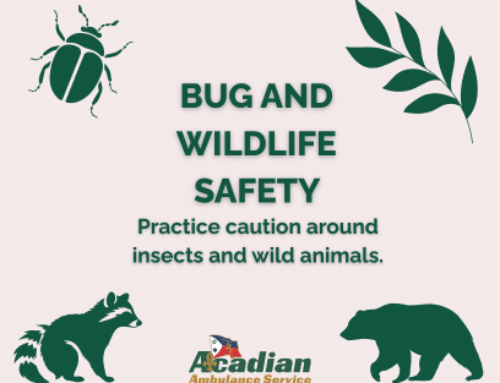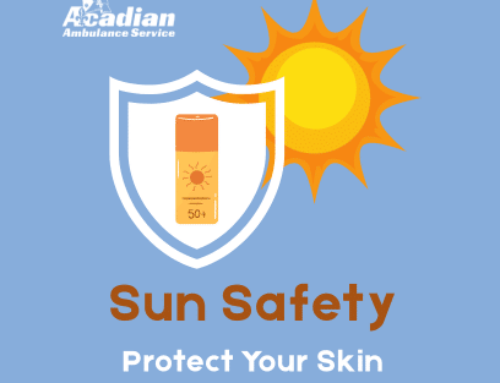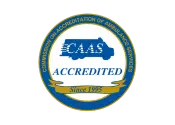Motor vehicle injuries are a leading cause of death among children in the United States. But many of these deaths can be prevented by properly using child car seats. Every parent and caregiver is responsible to ensure that all children under their care are as safe as can be at all times. While riding in a motor vehicle, the only way to do this is to ensure the child is properly restrained. Children under 13 years old don’t belong in the front seat!
Statistics
- Car seat use reduces the risk for death to infants (aged <1 year) by 71%; and to toddlers (aged 1–4 years) by 54% in passenger vehicles.
- Booster seat use reduces the risk for serious injury by 45% for children aged 4–8 years when compared with seat belt use alone.
- For older children and adults, seat belt use reduces the risk for death and serious injury by approximately half.
Car seat safety tips:
- Always follow your car seat’s height and weight limits.
- Make sure your car seat can be correctly installed in your vehicle.
- Keep the retainer clip (chest clip) fastened at armpit level – not over their belly.
- Be sure to check the weight limits on LATCH-fastened car seats. In order to use the LATCH system, the sum of the child’s weight and the weight of the car seat must be no more than 65 pounds. If the weight exceeds that, use a locking seat belt to secure your car seat.
- If you’re in doubt of which way your child should ride, choose the more protective category.
Cold weather safety tips:
- Bulky clothing, including winter coats and snowsuits, should not be worn underneath the harness of a car seat. In a car crash, fluffy padding immediately flattens out from the force, leaving extra space under the harness. A child can then slip through the straps and be thrown from the seat.
- Store the carrier portion of infant seats inside the house when not in use.
- Get an early start.
- Dress your child in thin layers.
- Don’t forget hats, mittens, and socks or booties.
- Tighten the straps of the car seat harness.
- Use a coat or blanket over the straps.
- Use a car seat cover ONLY if it does not have a layer under the baby.
- Remember, if an accessory did not come with the car seat, it has not been crash tested and may interfere with the protection provided in a crash.
Louisiana’s timeline of car seat requirements:
- The 2019 Louisiana Child Passenger Safety Law requires that children ride in a rear-facing car safety seat from birth to 2 years old in an infant or convertible child safety seat.
- When the child is at least 2 years old and outgrown their rear-facing seat by height or weight, they should remain in a forward-facing car safety with an internal harness.
- When the child is at least 4 years old and has outgrown their forward-facing, internal harness seat, they must ride restrained in a belt-positioning booster seat.
- When the child reaches 9 years old and has outgrown their booster seat and can pass the 5-step test (see the green graphic on this page), they should ride restrained with a lap shoulder belt secured correctly.
- All children younger than 13 years should be properly restrained in the rear seats of vehicles for optimal protection.
Child passenger safety information by state
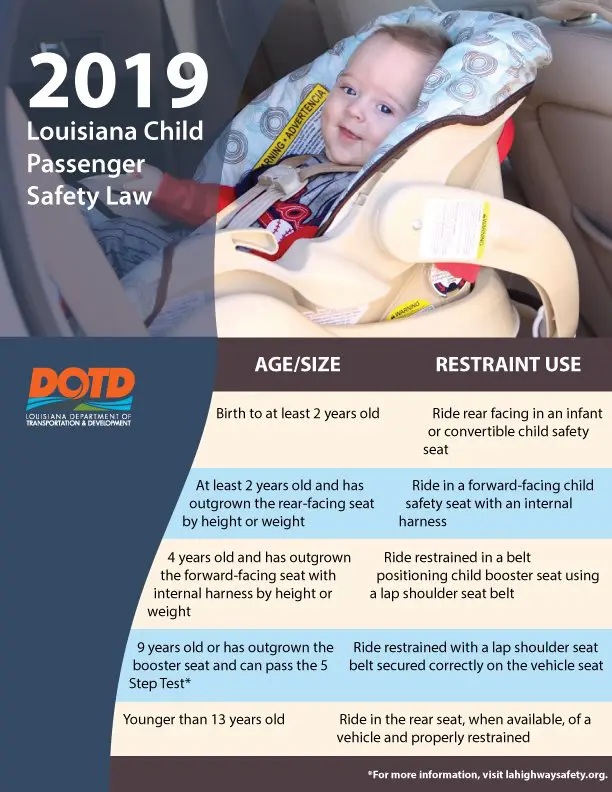

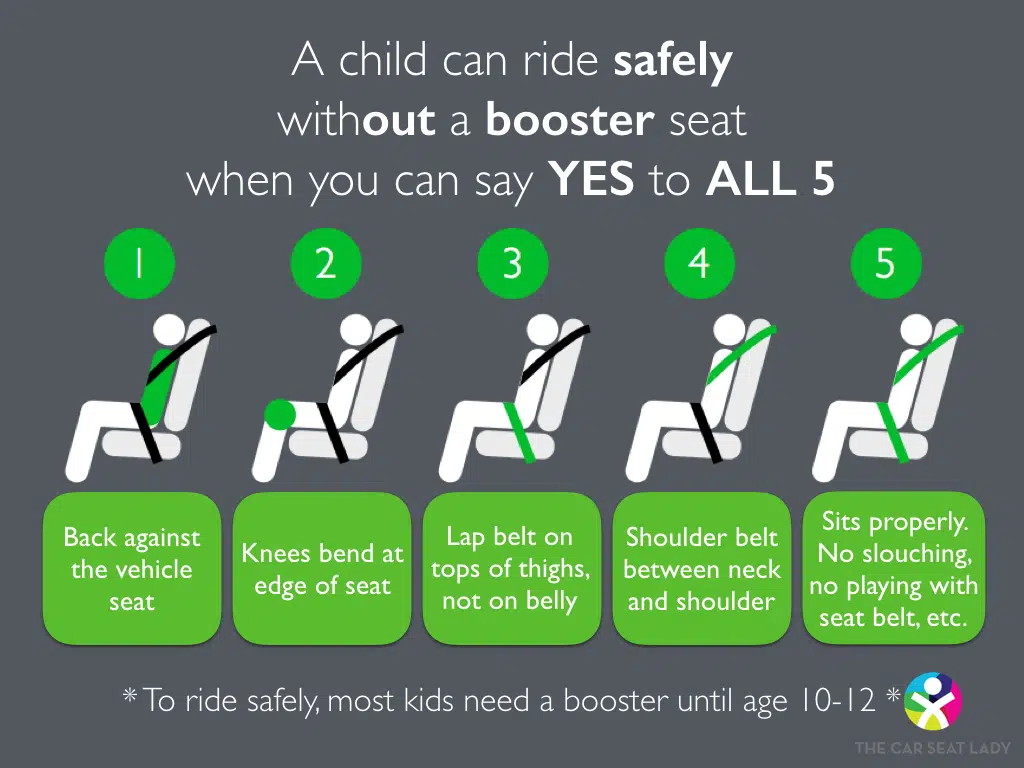
The 5-step test says that a child can ride safely without a booster seat if they meet these 5 requirements:
- Back against the vehicle seat
- Knees bend at the edge of the seat
- Lap belt on top of thighs, not belly
- Shoulder belt between neck and shoulder
- Sits properly without slouching, playing with seat belt, etc.
What about if you get into a crash?
Recent studies demonstrate that child safety seats can withstand minor crash impacts without any documented degradation in subsequent performance. Read and follow your manufacturer’s guidelines.
- The NHTSA recommends that child safety seats do not automatically need to be replaced following a minor crash, defined as a crash where ALL of these criteria are met:
- The vehicle was able to be driven away from the crash site
- The vehicle door nearest the safety seat was undamaged
- There were no injuries to any of the vehicle occupants
- The air bags (if present) did not deploy
- There is no visible damage to the safety seat
Where can I get my car seat fitted and/or inspected?
- LOUISIANA
- The Louisiana State Police offers child car seat inspections for the public.
- Refer to this Louisiana Highway Safety Commission page to find out when your region’s Troop holds car seat inspections and find other grant-funded fitting stations.
- TEXAS
- Enter your location at the National Highway Traffic Safety Administration website to find a car seat inspection point near you.
- Learn more from the Texas Department of Public Safety.
- MISSISSIPPI
- Contact the Mississippi State Department of Health for information on installations and seat checks.
- TENNESSEE
- Find a location on the Tennessee Highway Safety Office website.
Information sources:
-
- https://www.womans.org/services/pregnancy-childbirth/new-parent/car-seat-safety
- https://www.lahighwaysafety.org/our-programs/child-passenger-safety/
- https://www.nhtsa.gov/vehicle-safety/car-seats-and-booster-seats
- https://www.healthychildren.org/English/safety-prevention/on-the-go/Pages/Car-Safety-Seats-Information-for-Families.aspx
- https://www.facebook.com/BuckleUpLouisiana/
- https://www.healthychildren.org/English/safety-prevention/on-the-go/Pages/Winter-Car-Seat-Safety-Tips.aspx


